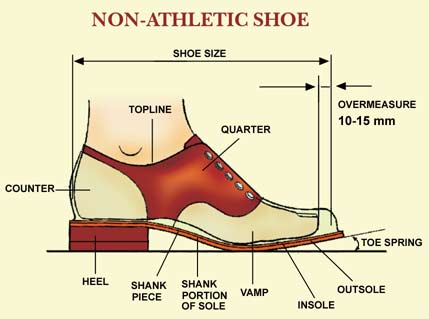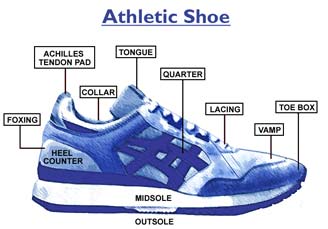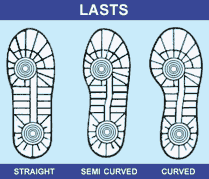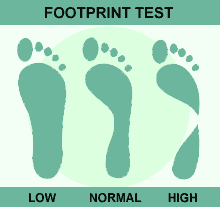Ng Min Li
Physiotherapist
Tremendous pressure is placed on our feet as they faithfully support us upright and transport us from place to place. Properly fitted shoes help to reduce the load on our feet while ill-fitted shoes can cause not only foot problems but pain in the ankle, shin and knee as well. To be able to select a pair that fits you well, you need to familiarise yourself with the structure of a shoe.
Structure of a Shoe
Basically, shoes can be classified into two types: the non-athletic shoe and the athletic shoe. The main components of a shoe are the upper and the bottom. The upper is the part that encloses the foot. It includes the toe box, vamp, quarter, heel counter, collar or topline. The bottom components are the outer sole, midsole and inner sole, and they support the foot and make contact with the ground.


The Upper
Toe Box. The toe box and the vamp form the front portion of the shoe, covering the toes and the forefoot. It should be wide enough to accommodate the forefoot and toes comfortably without squeezing the toes together. The toe box should also be high enough to allow toe movement and reduce friction between the toes and the top of the toe box. In non-athletic shoes, especially female footwear, the shape and size of the toe box are often compromised, resulting in foot deformities as well as painful calluses and blisters. When selecting the size of the shoe, there should be a spacing of at least 1.5cm (or one thumbnail) between the longest toe and the end of the toe box. This prevents jamming, nail injury and blisters, and accommodates foot expansion during sporting activities or prolonged standing or walking.
Quarter. The quarter refers to the upper part of the shoe that extends from the back round either side of the foot. The quarter, eyestay and collar or topline determine the comfort and fit of the shoe. A good fit will provide stability for the foot. Choose a material that is flexible and allows the foot to "breathe".
Heel Counter. The heel counter forms the back portion of the shoe. It is the major stabiliser of the rearfoot and it provides support and cushion to the heel. It should be firm and should fit snugly and comfortably around the heel. The quarter lining covers the heel counter, and in athletic shoes, it is reinforced with a foxing. In some shoes, extra stability is provided by the external heel counter, which is usually a hard, rigid plastic placed outside of the heel counter.
The Bottom
Outsole. The outsole is the part of the shoe that comes into contact with the ground. It is made of a material that provides traction, flexibility and some cushioning. Carbon rubber and blown rubber are commonly used materials. Carbon rubber is hard and more durable but it tends to be relatively heavy. Blown rubber has air injected into it and provides some cushioning. In many shoes, a combination of both types of rubber may be used - carbon rubber in high wear areas of the rearfoot and blown rubber for the forefoot area to allow toe movements. In athletic shoes, the outsole is often patterned differently for different sports to provide efficient traction on different terrain.
Midsole. The midsole is the part of the shoe between the outsole and the insole. It plays an important role in shock absorption. In athletic shoes, the midsole replaces the shank and heel seen in non-athletic shoes. It is the part of the shoe that has been widely researched and is often the characteristic feature for the particular brand of shoe.
Common materials used in midsoles are two types of foam called ethylene vinyl acetate (EVA) or polyurethane. EVA is a firm but resilient foam and may be produced in different densities with varying degrees of stability and cushioning. However, it is not durable and breaks down quickly. Polyurethane is a denser and more durable foam but it is heavier and provides a lesser degree of cushioning. Hence, to achieve a combination of lightness, cushioning and durability, some manufacturers have devised midsoles that encapsulate air or gel or use a combination of EVA and polyurethane.
Besides providing shock absorption of the rearfoot during heel strike (the instant when the heel hits the ground during walking or running), the midsole also provides rigidity to prevent twisting of the shoe. Another recent improvement in shoe design is better support at the midsole - many manufacturers are incorporating support features to improve stability and reduce overpronation (excessive inward tilting of the ankle and flattening of the foot arches). Some utilise contoured midsoles and some use a plastic medial post placed within the midsole.
Insole. The insole consists of an insole board (structure for joining the upper and bottom) and an insole (sock liner) that lies on top of the insole board. The liner is made of nylon, foam or terrycloth. It mainly serves to absorb sweat, providing little cushioning. In modern shoe designs, the insole is removable and can be replaced.
Last. The last is a three-dimensional structure, shaped in the outline of a foot, over which the components of the shoe are moulded and made. There are three basic shapes of the last: straight, semi-curved and curved. Shoes with a straight last provide maximum support for longitudinal arch of the foot, and are usually suitable for controlling overpronation. On the other hand, shoes with a curved last are suitable for those who underpronate.

To determine what type of lasts suits you, you need to know if your feet have high, normal or low arches when you stand. A quick way to ascertain this is to examine your footprints. First, wet your feet and make a footprint on a hard surface. If the imprint shows a narrow band connecting the forefoot and the heel, you have a high arch. If the imprint looks like the whole sole of the foot, you have a low arch. Feet with normal-sized arch leave an imprint that has a flare but shows the forefoot and the heel connected by a wide band. For those with high arches when standing, cushioned shoes with a curved last and with better flexibility will compensate for the more rigid feet. For those with low arches, motion-control or stability shoes with a straight last and with firmer midsoles will provide stability and control for the excessively flexible feet. For those with normal-sized arches, a semi-curved last is recommended.

Selecting athletic footwear
Choosing athletic footwear depends on the type of activity or sports for which it is used - i.e. sport-specific. In general, footwear for aerobics should have good forefoot cushioning and must be light for quick moves but yet providing adequate torsional support. Walking shoes need extra shock absorption at the heel as well as soles that provide good roll off at the toes. Tennis shoes require good side-to-side support and must be moderately rigid. The midsole should provide good cushioning but must be thin so that the athlete's centre of gravity is lowered and side-to-side ankle motion is reduced. Basketball shoes require excellent ankle stability and shock absorption because of jumping, and high tops are more suitable.
General principles for the right fit
To get a good fit, you should:
- Try to shop at the end of the day or after a workout when your feet are at the largest.
- Wear your workout socks when trying on the shoes.
- Avoid choosing shoes by the size you have worn in the past. Try on the shoes as foot size changes with age and shoe sizes vary between manufacturers.
- Make sure both shoes fit.
- Ensure that the shoe provides at least one thumbnail's width of space between the longest toe to the end of the toe box.
- Ensure that the widest part of your foot is in the widest part of the shoe. The sides of the foot should not extend over the sole of the shoe, and your foot shouldn't move from side to side inside the shoe.
- Check that the shoe bends at the ball of the foot and not at the arch.
Here's how to get the best out of your shoes:
- Take time to adapt to your new shoes.
- Let shoes air dry between uses. You can alternate pairs to ensure drying.
- Change the insole if it breaks down.
- Monitor the shape and condition of your shoe to determine if you need a new pair.
- Estimate your mileage. Shoes lose their shock absorption properties relatively quickly, usually at 1000 kilometre of running. So, even if the shape of the shoe is maintained, it may still be worn out.
References:
- Agosta J (1995): "The foot and ankle: podiatric considerations" in Sports Physiotherapy edited by Zuluaga M, et al, Churchill Livingstone
- Martin DR (1997): "Athletic shoes: finding a good match" The Physician and Sportsmedicine Vol. 25 No 9
- Nesbitt L (1999): "How to buy athletic shoes" The Physician and Sports Medicine Vol. 27 No 12
- Reid DC (1992) Sports Injury Assessment and Rehabilitation Churchill Livingstone
Date reviewed: 26 April 2005